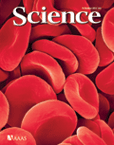In this week's issue:
|
|
| Research Summaries |
|
Editor summaries of this week's papers.
Highlights of the recent literature.
|
|
| Editorial |
|
|
|
| News of The Week |
|
In science news around the world, scientists rate a Namibian site as the top choice for the southern array of the planned Cherenkov Telescope Array, the Dutch government will take Russia to court over the seizure of a Greenpeace vessel protesting oil drilling in the Arctic, the company 23andMe's "designer baby" patent comes under fire from bioethicists, and more.
RoboRoach, a do-it-yourself neuroscience experiment in which humans (as young as 10 years old) with smartphones can direct cockroaches' movements via electrodes attached to their antennae, was unveiled at the TEDx conference last week. And the carnivorous purple pitcher plant is the 2 millionth plant specimen to be digitized at the New York Botanical Garden's online herbarium.
|
|
| News & Analysis |
|
Prizes
Daniel Clery
Two theorists whose work set the stage for finding the Higgs boson won the Nobel Prize in physics this week, while three biologists who explored various aspects of how cells package, transport, and release their internal proteins earned the physiology or medicine prize.
Prizes
Elizabeth Pennisi and Emily Underwood
Three biologists who explored various aspects of how cells package, transport, and release their internal proteins earned the Nobel Prize in physiology or medicine.
Science Funding
David Malakoff
The second week of the U.S. government shutdown found scientists more worried than ever about its long-term impact on research.
Policy
Jeffrey Mervis
NASA has told several Chinese students at U.S. universities that they cannot attend an astrophysics conference next month at its Ames Research Center.
Dual-Use Research
Martin Enserink
A Dutch ruling is raising complex questions about how the Netherlands will regulate sensitive biomedical research.
Psychiatric Research
Charles Schmidt
A clinical group in Maine this month is spearheading a six-member network to study children with severe autism.
Ancient DNA
Michael Balter
The transition from foraging to farming in Europe was long and messy, according to two papers published in Science this week.
Japan
Dennis Normile
Japan's Cabinet is looking to double the budget of the Okinawa Institute of Science and Technology next year; university governors met with Prime Minister Shinzo Abe to outline expansion plans.
|
|
| News Focus |
|
Daniel Clery
Planetary scientists thought they had explained what made the moon, but ever-better computer models and rock analyses suggest reality was messier than anyone expected.
Robert F. Service
The explosion of publicly available databases housing sequences, structures, and images allows life scientists to make fundamental discoveries without ever getting their hands "wet" at the lab bench.
|
|
| Letters |
|
Sang-Won Lee et al.
Kristin L. Rising and Nicole Lurie
Douglas H. Johnson and R. Dennis Cook
Daryl E. Chubin
|
|
| Books et al. |
|
Pharmaceutics
Wendy Lawley et al.
Dalrymple provides a community record of efforts to counter malaria with artemisinin-based therapies, especially in Africa.
Health Care
Richard S. Mathis
Taking a behavioral economics perspective, Hough considers a range of anomalies in U.S. health care.
A listing of books received at Science during the week ending 04 October 2013.
|
|
| Policy Forum |
|
Medicine
Bridget Wilcken
Despite improvement and increased testing, standards and practice in screening babies for rare disorders remain muddled.
|
|
| Perspectives |
|
Neuroscience
Byoung-il Bae and Christopher A. Walsh
Human cerebral organoids grown in the lab may quickly advance our understanding of brain development and disease.
Materials Science
Markus Heyde
The structure and dynamics of a two-dimensional silica film provide fundamental insights into amorphous materials. [Also see Report by Huang et al.]
Applied Physics
Yeshaiahu Fainman and George Porter
A data center design based on an integrated chip-scale approach will be required to deal with the increasing volumes of Internet traffic.
Development
Benjamin D. Simons
Mechanical forces exerted between tissue layers in the intestine are all that is needed to make gut villi. [Also see Research Article by Shyer et al.]
Ecology
Emily S. Bernhardt
Efforts to reduce the phosphorus input to lakes have helped to lessen algal blooms but exacerbated nitrate pollution. [Also see Report by Finlay et al.]
Genetics
Ross C. Hardison and Gerd A. Blobel
Genetic and epigenetic studies of gene variants reveal a potential genomic target for treating hemoglobin disorders. [Also see Report by Bauer et al.]
Molecular Biology
Selena M. Sagan and Peter Sarnow
No longer elusive, mammalian antiviral RNA interference is now confirmed. [Also see Reports by Li et al. and Maillard et al.]
|
|
| Reviews |
|
|
|
| Research Articles |
|
David Jukam et al.
Hippo directs cell differentiation and fate through context- and tissue-specific feedback and transcription networks.
Amy E. Shyer et al.
Muscular control over proliferating mesenchyme and epithelium yields intestinal villi. [Also see Perspective by Simons]
|
|
| Reports |
|
J. Farihi et al.
Spectroscopic analysis of a debris-accreting star in its latest stage of life reveals the remnants of a water-bearing world.
D. Milathianaki et al.
The response to shock in polycrystalline copper is seen to evolve from elastic to plastic using ultrafast x-ray diffraction.
Pinshane Y. Huang et al.
Dynamics of individual atoms in a two-dimensional silicate glass have been observed using transmission electron microscopy. [Also see Perspective by Heyde]
Scott French et al.
Mantle convection produces low-wavelength fingerlike structures parallel to the directions of plate motion.
Yang Li et al.
Certain mammalian cells can use RNA interference in the innate defense against invading viruses. [Also see Perspective by Sagan and Sarnow]
P. V. Maillard et al.
Certain mammalian cells can use RNA interference in the innate defense against invading viruses. [Also see Perspective by Sagan and Sarnow]
Jean-Baptiste Vannier et al.
A DNA helicase that protects telomeres is also required for replication of the rest of the genome.
Yi Shi et al.
Four amino acids in the H7N9 influenza virus binding site provide a hydrophobic environment for human receptors.
Jacques C. Finlay et al.
Successful control of phosphorus levels results in nitrogen accumulation in many of Earth’s largest lakes. [Also see Perspective by Bernhardt]
Brian T. Ho et al.
A general bacterial defense mechanism suppresses the movement of horizontally transferred DNA in bacterial populations.
Daniel E. Bauer et al.
Fine-mapping reveals a promising therapeutic target for genome engineering in the β-hemoglobinopathies. [Also see Perspective by Hardison and Blobel]
Guido Brandt et al.
Mitochondrial DNA profiles of 364 prehistoric people reveal human demography and migration patterns in Neolithic Germany.
|
|
| Podcast |
|
Listen to stories about gaps in the evidence for newborn screenings, the formation of the moon, removing nitrogen from lakes, and more.
|
|
| New Products |
|
A weekly roundup of information on newly offered instrumentation, apparatus, and laboratory materials of potential interest to researchers.
|
|
| From the AAAS Office of Publishing and Member Services |
|
Business Office Feature
Jeffrey M. Perkel
|












